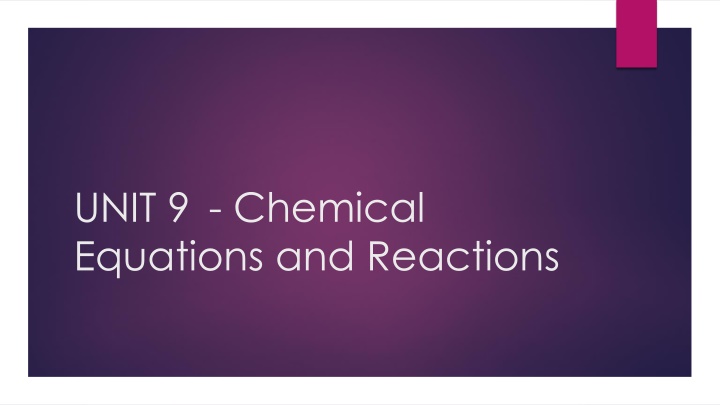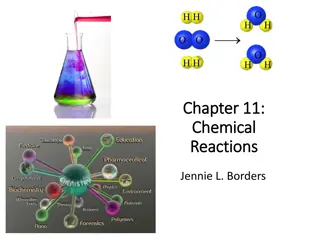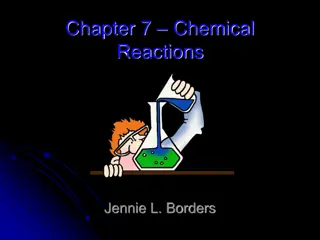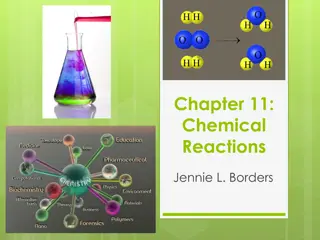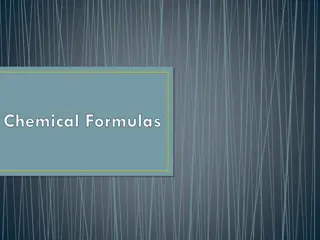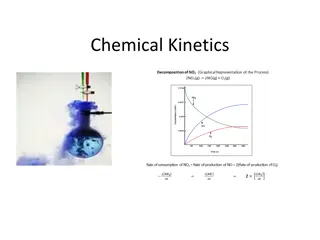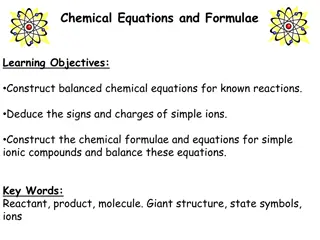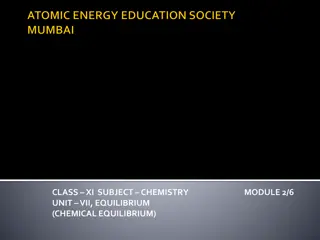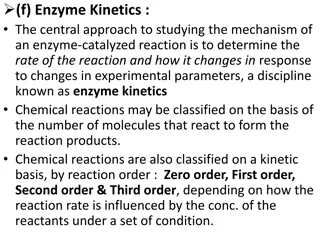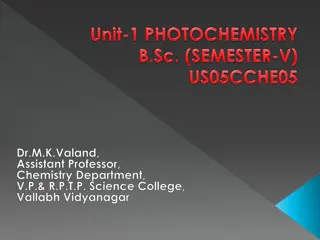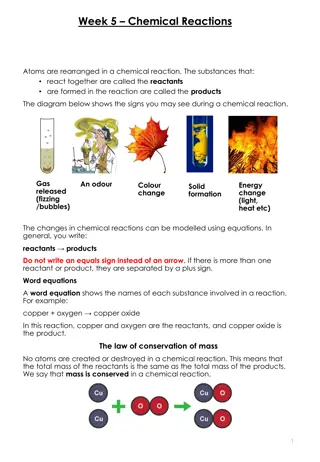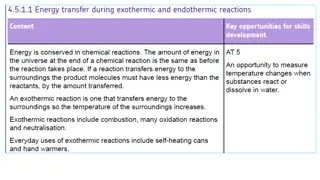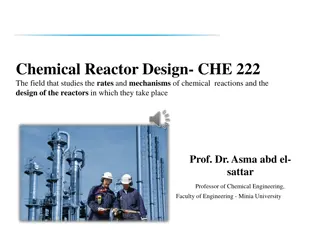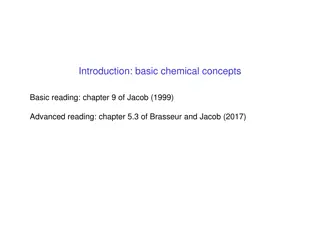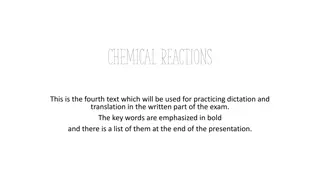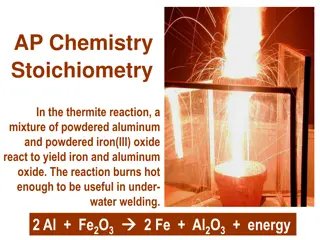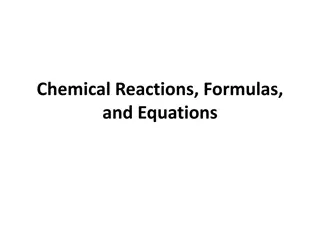Chemical Equations and Reactions
This unit explores the fundamentals of chemical equations and reactions, emphasizing key concepts and principles. Learn about balancing equations, types of reactions, and their applications in chemistry. Gain a solid understanding of stoichiometry, reaction kinetics, and more through practical examples and explanations.
Download Presentation

Please find below an Image/Link to download the presentation.
The content on the website is provided AS IS for your information and personal use only. It may not be sold, licensed, or shared on other websites without obtaining consent from the author.If you encounter any issues during the download, it is possible that the publisher has removed the file from their server.
You are allowed to download the files provided on this website for personal or commercial use, subject to the condition that they are used lawfully. All files are the property of their respective owners.
The content on the website is provided AS IS for your information and personal use only. It may not be sold, licensed, or shared on other websites without obtaining consent from the author.
E N D
Presentation Transcript
UNIT 9 - Chemical Equations and Reactions
Describing Chemical Reactions Chemical Reaction process in which one or more substances are changed into one or more different substances Reactants original substance Products resulting substance Described by Chemical Equations Chemical equation represents, with symbols and formulas, the identities and molar amounts of the reactants and products in a chemical reaction (NH4)2Cr2O7(s) N2(g) + Cr2O3(s) + 4H2O
Physical Indicators To know that a chemical reaction has taken place requires evidence that one or more substances have undergone a change in identity. Release of heat and light Color change Production of gas (bubbles) Form a precipitate Solid that is produced as a result of a chemical reaction in solution
Writing Word Equations An equation in which the reactants and products in a chemical reaction are represented by words Arrow react to yield yield produce form Example: When methane burns it is combined with oxygen to produce carbon dioxide and water: Methane + oxygen carbon dioxide + water
Practicing Word Equation Solid sodium reacts with a solution of aluminum chloride to produce aqueous sodium chloride and aluminum metal. Fluorine gas is bubbled through a solution of sodium bromide to produce bromine gas and aqueous sodium fluoride. Potassium chloride and water are produced from solutions of potassium hydroxide and hydrochloric acid.
EXIT SLIP 1.) Solid mercury (II) oxide decomposes to produce liquid mercury metal and gaseous oxygen. 2.) Solid zinc is added to an aqueous solution containing hydrochloric acid to produce gaseous hydrogen that bubbles out of solution and zinc (II) chloride that remains 3.) Ammonia gas (NH3) reacts with hydrogen chloride gas to form ammonium chloride gas. 4.) Zinc metal reacts with copper (II) nitrate solution to form zinc (II) nitrate solution and copper solid. 5.) Iron metal reacts with aqueous sulfuric acid to form iron (II) sulfate solution and hydrogen gas.
Bellringer Which substances are on the left hand side of the chemical equation? Which substances are on the right hand side? List 3 physical indicators. What does (aq) mean? NH3+ H2SO4 (NH4)2SO4 Is this correct? Why not? What law does it break? How can you fix it?
Chemical equations must satisfy the Law of Conservation of Mass The equation must contain the correct formulas for the reactants and products The law of conservation of mass must be satisfied Same number of atoms of each element must appear on each side of the correct chemical equation Coefficient small whole number that appears in front of a formula in a chemical equation
Chemical equations MUST be balanced Balancing an equation Relative amounts of reactants and products represented in the equation must be adjusted so that the numbers and types of atoms are the same on both sides of the equation Carried out by inserting coefficients
HOW? __ CH4 (g) + __ O2 (g) __ CO2 (g) + __ H2O (l) Count atoms of elements that only appear once on each side of the equation (usually leave H and O for last) C atoms: _______ _______ H atoms: _______ _______ O atoms: _______ _______ Add any coefficient necessary to balance the atoms for each element individually C is balanced. Add a ______ in front of H2O Add a ______ in front of O2 Count atoms to be sure the equation is balanced
Bellringer 1.____ Na3PO4 + _____ CaCl2 ____ NaCl + ____ Ca3(PO4)2 2.____ K + ____ Cl2 3.____ Al + ____ HCl ____ KCl ____H2 + ____ AlCl3 ____ NF3 4.____ N2 + _____ F2 5.____ SO2 + ____ Li2Se ____SSe2 + ____Li2O 6.____ NH3 + ____ H2SO4 ____ (NH4)2SO4
Practice 1.) Solutions of calcium nitrate and sodium hydroxide react to produce sodium nitrate in solution with solid calcium hydroxide. 2.) Copper (II) chloride is reacted with solid aluminum metal. Copper metal is produced as a solid and aluminum chloride is left in solution.
5 types of Chemical Reactions Synthesis Decomposition Single-displacement Double-displacement Combustion
Synthesis Two or more substances combine to form a new compound: A+ X AX A and X can be elements or compounds; AX is compound Ex: 2Mg(s) + O2(g) 2MgO(s)
Synthesis Practice Na + Cl2 Al(s) + O2
Decomposition A single compound undergoes a reaction that produces two or more simpler substances: AX A + X A and X can be elements or compounds; AX is compound Ex: CaCO3(s) CaO(s) + CO2(g) I will always give you the products for decomposition
Combustion Reaction A substance combines with oxygen, releasing a large amount of light and heat (always results in production of carbon dioxide and water vapor) C3H8(g) + 5O2(g) 3CO2(g)+ 4H2O(g)
Combustion Reaction Practice C5H8 + O2 The combustion of octane.
Bell Ringer Solid potassium reacts with nitrogen gas Combustion of ethane C4H10(g) + O2(g) Copper (II) reacts with iodine
Single Displacement Reaction One element replaces a similar element in a compound: A + BX AX + B OR Y + BX BY + X A, B, X and Y are elements; AX, BX and BY are compounds Rule of thumb: cation will replace cation or anion will replace anion
Single Displacement Reaction Examples Displacement of Metal with another Metal: 2Al(s) + 3Pb(NO3)2(aq) 3Pb(s) + 2Al(NO3)3(aq) Displacement of Hydrogen in Water by a Metal: 2Na(s) + 2H2O(l) 2NaOH(aq) + H2(g) Displacement of Halogens: Cl2(g) + 2KBr(aq) 2KCl(aq) + Br2(l)
Activity Series of Elements What is it? A list of elements organized according to the ease with which the elements undergo certain chemical reactions How does it help? Helps you determine what substances will displace others in chemical reactions Used in single displacement reactions
Activity Series of Elements 2Al + 3ZnCl2 3Zn + 2AlCl3 Al is more reactive than Zn (higher on the activity series), so Al can replace Zn Co + 2NaCL no reaction Co is less reactive than Na (lower on the activity series), so it can not replace Na Cd + Pb(NO3)2 Cu + HCl
Single Displacement Practice Ca + H2O KI + Br2 H2 + ZnCl Cu + HCl
BELLRINGER Tell the type of reaction and predict the products: Ca (s) + N2 (g) Ti4+(s) + O2 (g) KI + Br2 H2 + ZnCl What type of reaction is the following: NH4OH(aq) NH3(g) + H2O(l)
Double Displacement Reaction The ions of two compounds exchange places in an aqueous solution to form two new compounds AX + BY AY + BX A, B, X and Y are ions; AY, BX are ionic compounds Rule of thumb: The cation and the anion of both compounds will switch
Double Displacement Reaction Examples Formation of precipitate: 2KI(aq) + Pb(NO3)2(aq) PbI2(s) + 2KNO3(aq) Formation of a Gas FeS(s) + 2HCl(aq) H2S(g) + FeCl2(aq) Formation of water: HCl(aq) + NaOH(aq) NaCl(aq) + H2O(l) As you can see in all examples the _________ and the ________ switch places
Double Displacement Practice AgNO3 + NaCl FeS + HCl H2SO4 + KOH
Type of Reactions Review Classify type of reaction N2 + 3H2 2NH3 2Li + 2H2O 2LiOH + H2 2NaNO3 2NaNO2 + O2 2C6H14 + 19O2 12 CO2 + 14H2O
Predicting Products Practice Predict the products, balance the equation and state the type of reaction: Copper (II) Nitrate reacts with sodium hydroxide Fluorine gas reacts with silver (II) iodide Ammonium carbonate reacts with potassium nitrate Silver (II) reacts with lithium acetate Calcium reacts with bromine gas Manganese (III) reacts with water
Net Ionic Equations Net ionic equation: includes only those compounds and ions that undergo a chemical change in a reaction in an aqueous solution Step 1: Convert chemical equation into a complete ionic equation All soluble ionic compounds (aq) are shown as dissociated ions The precipitates are shown as solids Ex: NaCl(aq) + AgNO3(aq) ---> AgCl(s) + NaNO3(aq) Complete Ionic Equation: Na+(aq) + Cl (aq) + Ag+(aq) + NO3 (aq) ---> AgCl(s) + Na+(aq) + NO3 (aq)
Net Ionic Equations Spectator Ions: ions that do not take part in a chemical reaction and are found in solution before and after reaction Step 2: Cross out all spectator ions Ex: NaCl(aq) + AgNO3(aq) ---> AgCl(s) + NaNO3(aq) Na+(aq) + Cl (aq) + Ag+(aq) + NO3 (aq) ---> AgCl(s) + Na+(aq) + NO3 (aq) Net Ionic Equation: Cl (aq) + Ag+(aq) ---> AgCl(s)
Solubility Rules Soluble ability of a compound to dissolve in a liquid solution
Net Ionic Equation Examples Pb(NO3)2(aq) + Na2S(aq) ---> Complete Ionic Eq: Net Ionic Eq: ammonium phosphate + calcium chloride ---> Complete Ionic Eq: Net Ionic Eq:
Net Ionic Equation Practice write complete ionic equation and the net ionic equation. Include coefficients, physical states and charges. A solution of aluminum bromide reacts with a solution of sodium hydroxide to form the precipitate aluminum hydroxide and aqueous sodium bromide. Aqueous copper (II) nitrate reacts with aqueous potassium carbonate, forming solid copper (II) carbonate and aqueous potassium nitrate.
Write complete and net ionic equations A solution of barium chloride reacts with a solution of magnesium sulfate, to form the precipitate barium sulfate and aqueous magnesium chloride. Aqueous potassium sulfide reacts with a solution of cadmium (II) chloride, to form solid cadmium sulfide and aqueous potassium chloride.
Write word and formula equations (be sure to include physical states): Solid sodium oxide is added to water at room temperatures and forms sodium hydroxide. Word equation: Formula equation: Balanced formula equation:
Word Equation Practice (be sure to include physical states): Solid aluminum carbide, Al4C3 reacts with water to produce methane gas and solid aluminum hydroxide. Word equation: Formula equation: Balanced formula equation:
Word Equation Practice (be sure to include physical states): The combustion of octane. Word equation: Formula equation: Balanced formula equation:
